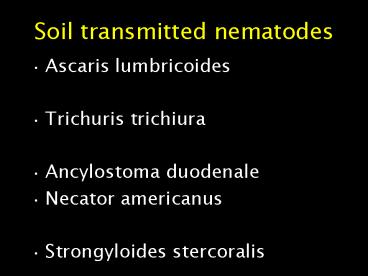The significance of Medical Parasitology - PowerPoint PPT Presentation
1 / 25
Title: The significance of Medical Parasitology
1
Soil transmitted nematodes
- Ascaris lumbricoides
- Trichuris trichiura
- Ancylostoma duodenale
- Necator americanus
- Strongyloides stercoralis
2
Soil-transmitted nematodes
3
Parasitic nematode of human importance
Disease Lymphatic filariasis Agent Wucheraria
bancrofti Vector-borne nematode Lymphatic
disease Elephantiasis WHO elimination programme
4
Filarial nematodes
- 8 species of filariae parasitise humans
- Occur in a wide range of habitats - lymph
glands, deep connective tissue, subcutaneous
tissue or mesenteries - Intermediate host or vector (insect)
- Adult worms parasites of vertebrate hosts which
produce characteristic larvae known as
microfilariae
5
Filarial nematodes
- 3 of the species are primarily responsible for
most cases of human filariasis (Two billion
exposed and at least 200 million infected) - Wucheraria bancrofti (lymphatic)
- Brugia malayi (lymphatic)
- Onchocerca volvulus (subcutaneous)
6
Wucheraria bancrofti
- Primary causative agent of lymphatic filariasis
- Overt bancroftian filariasis 115 million cases
worldwide (45.5 million India, 40 million
subsaharan Africa) - Widespread throughout the subtropics and tropics
(for e.g. Central Africa, India, Thailand,
Malaysia, Phillipines, Pacific Islands, Haiti,
coastal Brazil)
7
(No Transcript)
8
Different stages of the Wucheraria life cycle
9
(No Transcript)
10
Onchocerca volvulus Onchocerciasis
11
Microfilarial periodicity
- Periodic form mf in small numbers in
circulating blood during the day and peak density
at night (10 pm to 2 to 4 pm) - Subperiodic form mf peak between noon and 8 pm
- Periodic form mosquitoes feed at night
subperiodic form mosquitoes feed during the day
12
Gold standard diagnosis using blood films has
diminished relevance as mass drug distribution
expands
- Use of sentinel sites for ongoing night blood
films
13
Diagnosis of Wucheraria
- Frequently made on clinical grounds in endemic
regions but demonstration of microfilariae in
circulating blood is key - Where more than one species of filarial infection
occurs need well stained slides for morphological
identification of microfilariae - Filarial infections can occur without
microfilaremia
14
Diagnosis Wucheraria bancrofti
- Conventional method examination of thick smear
(stained)(counting chamber method) - Concentration techniques (Nucleopore filtration
or Knotts concentration) - Detection of circulating filarial antigen rapid
format card test/ immunochromatographic card test
(ICT) - Serodiagnosis
- PCR-based assays for DNA
- Imaging studies (high frequency ultrasound,
lymphoscintigraphy)
15
Characteristics of mf of W. bancrofti
- mf usually in blood
- 210-320um in length
- Loose sheath which when stained with Giemsa is
pale pinky blue and does not stain well - Nuclei are discrete and tail ends taper evenly
- No nuclei on the tip of the tail
16
Symptomatology
- Clinical manifestations vary considerably
- Asymptomatic microfilaraemics show microscopic
hematuria and/or proteinuria - Early signs fever, lymphangitis (limbs,
breasts, scrotum), lymphadenitis (femoral,
inguinal, axillary and epitrochlear nodes) - Orchitis, Lymphocoel, Hydrocoel
- Elephantiasis
17
Tropical pulmonary eosinophilia (TPE)
- Distinct syndrome in some individuals
- Paroxysmal cough and wheezing
- Weight loss, low grade fever, pronounced blood
eosinophilia - Total serum IgE and antifilarial Ab titres raised
- Responds well to treatment but in its absence
progressive pulmonary damage
18
Elephantiasis
- Relatively uncommon and late complication of
filariasis - Elephantiasis (enlargement of limbs, scrotum,
breasts or vulva with dermal hypertrophy
verrucous changes) - Impairment of circulation means secondary
bacterial fungal infections are common
19
Early lymphedema
Advanced lymphedema
Hydrocoele
Elephantiasis
20
Pathology
- Inflammatory changes in the lymphatics
- Repeated attacks of inflammation lead to dilation
thickening of the affected lymphatics
(lymphedema) - Chronic lymphedema hyperplasia of connective
tissue, infiltration of plasma cells, macrophages
eosinophils - Eventual thickening verrucous changes
elephantiasis
21
Immunology
- Intensity and type of host immune response may
reflect range of clinical manifestations - Immune response varies by stage of infection
- Immunomodulatory molecules
- Experimental animal models (B. malayi not W.
bancrofti)
22
Treatment
- Diethylcarbamazine (DEC) an effective
microfilaricidal drug which can eliminate adult
worms more slowly. Successfully administered in
table salt (Mass treatment) - Combination of DEC Albendazole
- Combination of DEC Ivermectin
- Elephantiasis surgery, rigorous hygiene
23
Prevention and control
- Transmission depends upon two issues
(availability of vectors and presence of a
population of people to infect the vector) - Vector control larvicides, residual spraying
- WHO programme to eliminate lymphatic filariasis
(GPELF) 2 prongs - stop spread of infection
reduce morbidity (mass treatment once yearly for
4-6 yrs, education and intensive local hygiene
GSK and Merck donation)
24
Case study Mass drug administration in India
- Mass treatment of 590 million people
- 1.4 billion doses of DEC and 0.51 billion of
Albendazole - 1.1 million drug distributors
- Challenges quality of DEC sometimes poor,
blister-packaging, side-effects, treatment
coverage variability (55-89 in better developed
states versus 0-35 in less), monitoring and
evaluation weak
25
Lymphatic filariasis elimination programme in
India progress and challenges
- Kapa D. Ramaiah
- Parasitology Today (2008) vol 25 (1) 7-8






![get [PDF] DOWNLOAD Medical Microbiology E-Book PowerPoint PPT Presentation](https://s3.amazonaws.com/images.powershow.com/10086233.th0.jpg?_=202407261011)










![[PDF] Spatial Analysis in Epidemiology Kindle PowerPoint PPT Presentation](https://s3.amazonaws.com/images.powershow.com/10100097.th0.jpg?_=20240816055)













